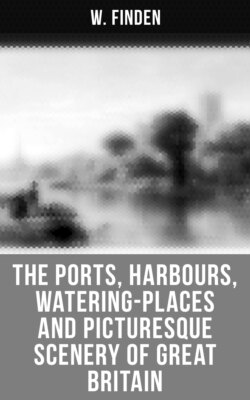Читать книгу The Ports, Harbours, Watering-places and Picturesque Scenery of Great Britain - W. Finden - Страница 8
На сайте Литреса книга снята с продажи.
YARMOUTH.
ОглавлениеTable of Contents
Yarmouth, in the county of Norfolk, sometimes called Great Yarmouth, to distinguish it from Yarmouth in the Isle of Wight, lies about 123 miles north-east of London, and about twenty-four to the eastward of Norwich. In the Vignette Engraving, from a beautiful painting by E. W. Cooke, the view is taken from the shore a little to the northward of the Jetty, which is seen extending into the sea. Nearly in the centre of the engraving is seen the column erected by the county of Norfolk to the memory of Nelson; and to the right are perceived several look-outs, like so many elevated scaffolds, from which, as the shore is very low, the pilots are enabled to take a wider survey when looking out for ships which may require their assistance.
The name of Yarmouth obviously alludes to the situation of the town near the mouth of the river Yare; the word Yare, according to Druery, in his Historical Notices of Great Yarmouth, is derived from the Celtic Iar, dark, supposed to have been given to this river from the dark colour of its waters. According to Sir Henry Spelman, the ground on which Yarmouth stands became firm and habitable in the year 1008, from the recession of the sea, and the accumulation of the sands. If this account be correct, it would appear that the town began to be built almost immediately afterwards; for in the Domesday-book, which was compiled between 1080 and 1086, the place is mentioned, with the usual carelessness of the Norman scribes, by the name of Cernemude; and the entry further records that the place had been held by King Edward [the Confessor], and that it "always had seventy burgesses."
In 1208, Yarmouth received a charter of incorporation from King John; and the privileges of the town were confirmed and enlarged by several succeeding kings. In 1228, in the reign of Henry III., Yarmouth had become a considerable port, both for the importation and exportation of merchandize; and in a charter of Edward I., granted in 1306, it is especially mentioned as a place where fishing-vessels, from an early period, had been accustomed to land the herrings which they caught during the season of the fishery. In 1347, Yarmouth supplied 43 ships and 1,095 mariners to the grand fleet of Edward III. and in 1349, the town was visited by a dreadful plague, which carried off seven thousand of the inhabitants. In the 31st of Edward III., an act was passed regulating the annual herring fair at Yarmouth, and appointing it to be governed by the barons of the Cinque Ports, according to the composition made between them and the inhabitants of the town in the reign of Edward I., the king's grandfather. One William Beukelem, of Biervliet, in Flanders, who died in 1397, according to Anderson, in his History of Commerce, is said to have been the inventor of the method of pickling herrings: but this cannot be correct; for though he may have introduced some improvements in the mode of cleaning and barrelling the fish, the inhabitants of Yarmouth and other places on the eastern coast were accustomed both to pickle and smoke herrings long previous to the time when the practice is said to have been introduced by Beukelem. Yarmouth is still the principal place of resort on the eastern coast of England for vessels engaged in the herring fishery, which there commences about the 21st September, and concludes about the 14th December. Most of the Yorkshire five-man boats come to Yarmouth in the herring season, and make their fishery from that place, disposing of all the herrings which they catch to curers who live in the town.
The quay at Yarmouth is one of the longest and most spacious of any in the kingdom; but from the shallowness of the entrance of the harbour, there being only fourteen feet of water on the bar at spring tides, the trade of the place is chiefly carried on in small vessels. It is high water in Yarmouth Roads at forty minutes past eight, and at Yarmouth Sands at thirty minutes past ten, on the full and change of the moon.
The column erected to the memory of Nelson stands on the low sandy flat, called the Denes, to the south of the town. Its total height, including the basement and the figure of Britannia at the top, is 144 feet, and it is ascended by a staircase consisting of 217 steps. It forms a conspicuous object when seen from the sea; and to the crews of vessels passing through Yarmouth Roads it is a proud memento of Nelson's fame and the naval glory of their country.
"O England!—dearer far than life is dear,
If I forget thy prowess, never more
Be thy ungrateful son allowed to hear
Thy green leaves rustle, or thy torrents roar!"
THE QUAY, YARMOUTH.
